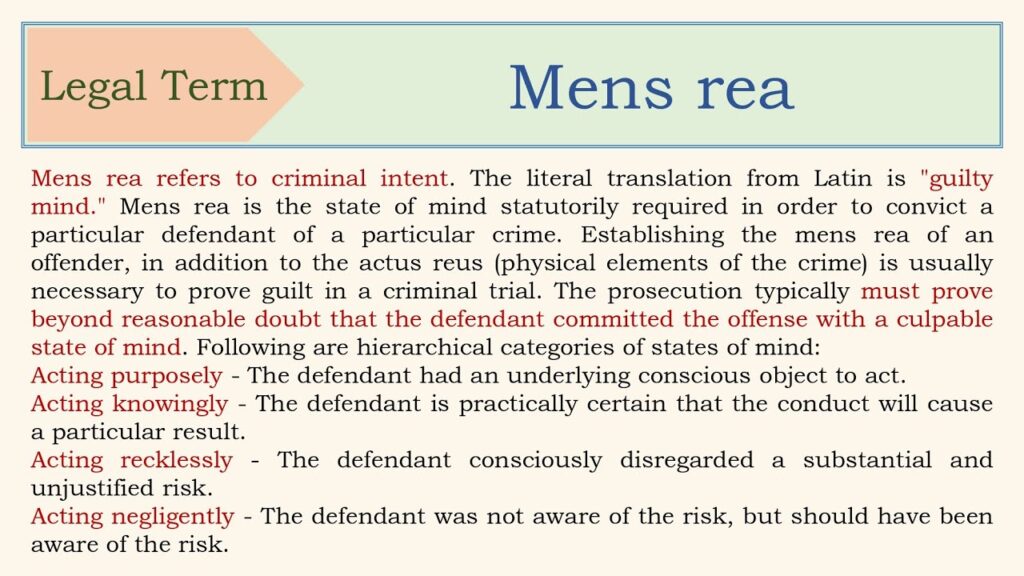
The legal system relies heavily on understanding the motivations behind actions. When determining guilt or liability, courts often delve into the “why” behind a person’s behavior. This is where the concept of intent comes into play. Does intent matter in law? Absolutely. It forms the bedrock of many legal decisions, shaping how crimes are defined and punishments are meted out.
This article will explore the multifaceted nature of intent in legal proceedings. We’ll define “mens rea,” examine the various types of intent recognized by law, and discuss the factors courts consider when assessing a defendant’s mental state. Finally, we’ll delve into the profound impact intent has on culpability, liability, and the overall legal landscape.
Mens Rea Definition
“Mens rea” is a Latin term that translates to “guilty mind.” In legal contexts, it refers to the mental state a person must possess when committing a crime. It essentially captures the level of awareness and purposefulness behind an action. Simply put, mens rea examines whether someone acted intentionally, knowingly, recklessly, or negligently.
The concept of mens rea is crucial because it distinguishes between accidental acts and deliberate wrongdoing. For instance, accidentally bumping into someone and causing them to fall is different from intentionally pushing them. The former lacks the necessary mens rea for a criminal charge, while the latter could lead to assault charges.
Different crimes have varying mens rea requirements. Some offenses, like murder, demand proof of specific intent – meaning the defendant acted with the deliberate purpose of causing harm. Others, like manslaughter, may only require proof of recklessness or negligence. Understanding these distinctions is vital for navigating the complexities of criminal law.
Types of Intent in Law

The legal system recognizes several distinct types of intent, each carrying different implications:
Specific Intent: This involves acting with a clear and deliberate purpose to achieve a specific outcome. For example, robbing a bank with premeditation demonstrates specific intent. The defendant planned the act and intended to steal money.
General Intent: This applies when the defendant acts knowingly and voluntarily, intending the general consequences of their actions but not necessarily a specific outcome. A classic example is assault – the defendant intends to cause harm but may not have a precise plan for how it will occur.
Transferred Intent: This occurs when the intended victim differs from the actual victim. For instance, if someone throws a rock intending to hit one person but accidentally hits another, the intent “transfers” from the original target to the actual victim.
Negligence: This involves failing to exercise reasonable care, resulting in harm. While not always considered a form of intent, negligence can still lead to civil liability. A driver who runs a red light and causes an accident may be deemed negligent.
- Recklessness: This involves consciously disregarding a substantial and unjustifiable risk. A person driving under the influence of alcohol is acting recklessly because they are aware of the danger but choose to drive anyway.
Factors Determining Intent
Courts rely on various factors to assess a defendant’s intent, often piecing together evidence from different sources:
- Motive: While not always conclusive, motive can provide insight into a person’s intentions. For example, if someone is found with stolen goods and their financial situation suggests they needed money, this could indicate a motive for theft.
Actions: A defendant’s behavior leading up to the alleged offense can be telling. If someone repeatedly threatens another person before committing an assault, their actions suggest intent.
Statements: Words spoken by the defendant, either before or after the act, can shed light on their mental state. For instance, confessing to a crime or making statements indicating premeditation can strengthen the case for specific intent.
- Circumstances: The surrounding context of an event can be crucial in determining intent. For example, a person who accidentally fires a gun during a heated argument may have acted recklessly, while someone who deliberately aims and shoots has acted with specific intent.
Culpability and Liability

Intent plays a pivotal role in determining culpability – the degree to which someone is responsible for their actions. The higher the level of intent, the greater the culpability. For example, premeditated murder carries a much heavier sentence than manslaughter because it involves a higher degree of intent.
Liability refers to legal responsibility for harm caused. Intent often directly influences liability. In civil cases, proving negligence or intentional wrongdoing is essential for establishing liability and seeking compensation. Similarly, in criminal law, intent is a key element in determining whether someone can be held criminally liable for their actions.
Conclusion
Does intent matter in law? The answer is unequivocally yes. Intent forms the very foundation of legal reasoning, shaping how crimes are defined, punishments are determined, and liability is assigned. Understanding the nuances of mens rea, the various types of intent, and the factors courts consider when assessing intent is crucial for navigating the complexities of the legal system. From criminal prosecutions to civil lawsuits, intent remains a central concept that profoundly impacts legal outcomes.
